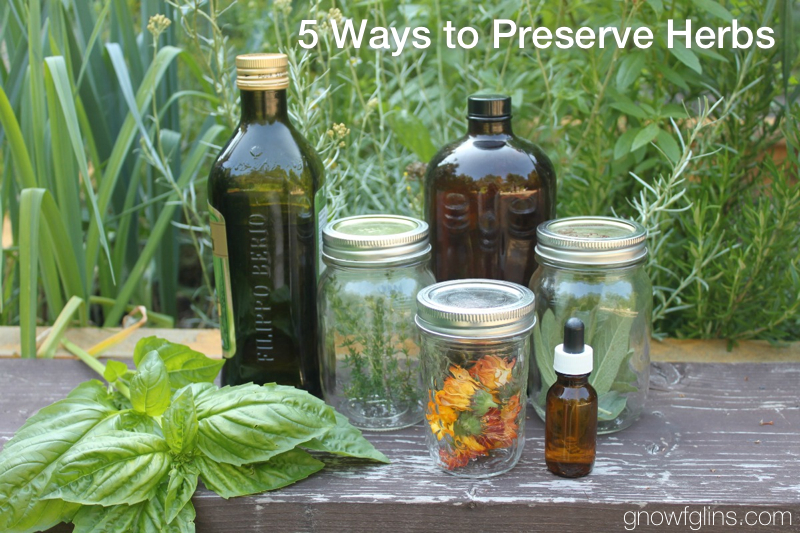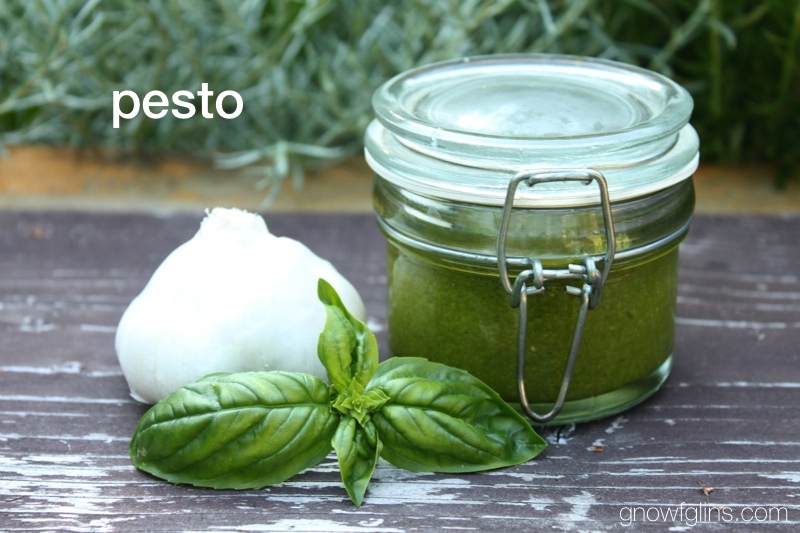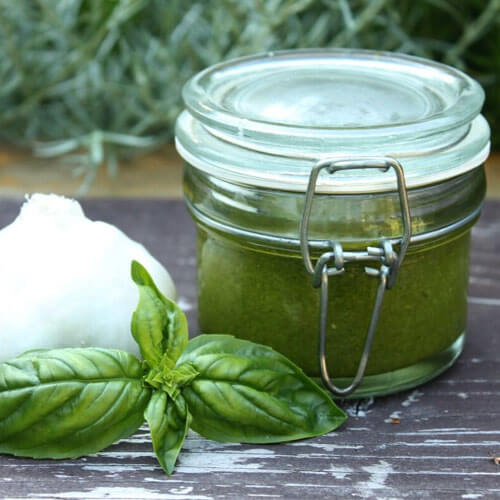
Fall is just about here and many of us are busy preserving the summer harvest. While you are freezing, canning, and dehydrating fruits and veggies, don’t forget to preserve your herbs, too! Both medicinal and culinary herbs can be preserved in a variety of ways for use throughout the year.
Here are five ways to preserve and store your herb harvest.
Freezing
I use the freezing method most often for culinary herbs since it is easy and quick. Harvest your herbs, make sure they are dry, place them in a labeled container, and freeze. Super simple. This works for just about all leafy herbs. To save time during the busy harvest season, I don’t bother to remove the stems because it’s easy enough to do when I pull them out of the freezer to use them.
You can also chop the herbs and put them into an ice cube tray with a little oil. Once frozen, pop them into a labeled bag or container. It’s a little more work on the front end, but can be a timesaver while cooking.
Drying
If freezing is the easiest, drying is probably the most common way to preserve herbs. Herbs can be dried in several ways. They are done when brittle and crumbly. This can take hours or days, depending on the herb and method.
Tie and hang: the traditional method. Gather your herbs, wrap a string around the stems, and hang upside down in a warm, dry spot. Wrap the herbs in a piece of muslin, cheesecloth, or paper bag with holes in it to keep the herbs clean and preserve any leaves that fall during the drying process.
Solar drying. If you live in a warm climate, place your herbs outside on a screen, cover them with a piece of muslin, and let the sun do its work.
Dehydrate. Use a dehydrator for the job, as ovens rarely maintain a low enough temperature and often do not provide enough air circulation for properly dried herbs. You’ll find complete dehydrating instructions in our member area or in our Dehydrating eBook.
Tincture
Medicinal herbs are most commonly used in tinctures. This is a great way to stock your herbal medicine cabinet! Place clean, dry herbs in a jar and cover with alcohol. Make sure you have a high alcohol content — vodka works well. Store the jar in a cool, dark place for six weeks, shaking the contents daily. Strain the herbs and pour the tincture into a fresh jar. Label and store.
Herbal-Infused Oil
Herbal-infused oils are used for both culinary and medicinal purposes.
Traditionally, fresh herbs are placed in a jar, covered with oil, and placed in a warm place for several weeks. The herbs are then strained out, and the oil kept for future use.
Recently, botulism has become a concern. Food safety experts now recommend making infused oils with only dried herbs (not fresh). This does add another step to the process, but may be worth it for peace of mind. Cover herbs completely with a high-quality oil (usually olive oil or sunflower, but others can be used) and let sit for at least two weeks. Strain the herbs and store the oil in a clean jar.
Herb-Infused Butter, Vinegar, or Pesto
Butter. Chop your herbs, mix with soft butter, and freeze in small portions. Use one part herbs to two parts butter. This is delicious for cooking or spreading on crusty pieces of homemade bread. The flavor combinations are endless!
Vinegar. Similar to an herbal oil or tincture, pop your herbs into a jar, cover with vinegar, and let sit for four to six weeks in a cool, dark place. Use about 1/2 cup herbs to 2 cups vinegar. Add more herbs if you prefer a strong flavor. For more information, read How to Make (and Use) Herbal Vinegar.
Pesto. One of my absolute favorite ways to preserve basil, although other leafy herbs make great pestos, too.


Basil Pesto
Ingredients
- 2 cups fresh basil
- 2 to 3 cloves garlic
- 1/4 cup nuts or seeds, pine nuts are traditional
- 1/2 cup extra virgin olive oil
- 1/2 cup hard cheese grated, parmesan is most common
- sea salt to taste
- pepper to taste
Instructions
-
Process all in a blender or food processor, or combine with a mortar and pestle.
-
Use right away or freeze*.
Recipe Notes
*Freezing Instructions
Hold back some of the oil when blending. Put the pesto in a container, cover with remaining oil, and freeze.
Pesto can also be frozen in ice cube trays, although I find it just as easy to freeze in mounds on parchment paper, and then transfer to containers.
How do you preserve your herbs? Please share your tips, tricks, and recipes in the comments!
We only recommend products and services we wholeheartedly endorse. This post may contain special links through which we earn a small commission if you make a purchase (though your price is the same).


What brand of vodka do you like to use? I tried to make sure it was in glass and not plastic, but could only find 80 proof. The organic stuff was so expensive!!
Thanks!
You might want to look at the Costco Kirkland Signature Brand Vodka it supposedly is manufactured by Grey Goose imported from France and beings there tolerance for non organics and GMO products is pretty low that has been my brand to choose.
I use 80 proof, as that is all that I have ever been able to find, and I don’t have a preferred brand. I didn’t even know there was such a thing as organic vodka!
I never knew you could freeze herbs! How interesting. My basil has gone to seed and is done but next year I will definitely keep this in mind. All I knew about were the dried methods and in the middle of all the summer canning, I never had time for that. This is great to know. 🙂
I felt the same way when I discovered that herbs could be frozen! It’s so quick and easy! Basil is something I have only ever frozen as pesto, which compared to the work of canning, is still easy to whip up and pop into the freezer.
The availability of higher proof vodkas varies by state. In some states you can purchase “Everclear” which is 190 proof (sometimes you have to ask because it won’t be on the shelf), and then dilute it to the proof you like to use. However, this is grain alcohol and is likely made with GMO corn. Organic vodkas are available, but are usually significantly higher in price. Buying a vodka distilled in a country that does not support GMOs or trying potato vodka would be alternatives.
We froze our pesto and now have had an ice storm and were without power for 6 days. Our pesto thawed but was never taken out of the freezer (just not power to the freezer). Is it still ok to re-freeze and/or use?
Hi Sherry, you will need to gauge how warm your freezer got. I would not refreeze but if it stayed cool you might be able to use it up asap. Remember if it smells or tastes bad, it’s probably not good.
~ Vicki, TCS Customer Success Team